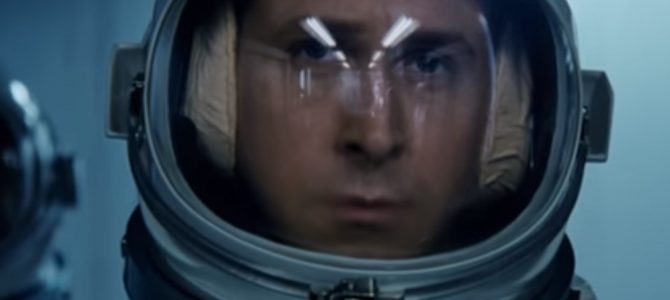
First man on the moon Neil Armstrong may truly have been a grim, all-business straight arrow, perpetually haunted by the death of his daughter and coldly distant from his wife and two young sons. But in First Man, the usually excellent Ryan Gosling plays him as such a glassy-eyed, passionless drone that the unexcitable astronaut almost comes off as autistic.
Even when Armstrong unconsciously breaks a glass upon receiving bad news, the act comes as just as much of a surprise to him as it is to us. All he can do is stare blankly at what he has done, like an expressionless robot confronted with a does-not-compute situation.
Armstrong’s inhuman iciness during most of the two-and-a-half-hour drama may have been contrived by director Damien Chazelle (Whiplash, La La Land) in order to make something Armstrong does after finally getting to the moon feel more devastating. Unfortunately, that particular incident is completely fictional, with no basis in fact, despite being the movie’s most tearjerking moment.
Taking artistic liberty with a scene like the one in which a lunar landing vehicle test flight leaves half of Armstrong’s face a bloody mess, even though the incident actually resulted in nothing more than a bitten tongue, is one thing. Completely making up a dramatically powerful but fraudulent historical detail is another.
What’s ironic is that most of the rest of the movie is almost mundanely reality-based, following Armstrong’s no-nonsense, through-the-ranks NASA career as well as his awkward family life. Claire Foy (Netflix’s The Queen) plays Armstrong’s taken-for-granted stay-at-home wife Janet, who puts up with so much inattention from him that it’s only a matter of time before she ends up throwing something during a shouting scene.
Breaking up the training exercises and domestic disharmony, Armstrong’s earthbound and space excursions are shot with a jarring you-are-there tension. An early, almost catastrophic test flight that inadvertently sends Armstrong’s jet beyond Earth’s atmosphere manages to be engrossingly terrifying, even though we logically know he has to survive in order to take his famous “one small step” years later.
On his Gemini (which everyone in the cast pronounces as if it rhymes with “jiminy”) mission, liftoff is portrayed without exterior shots, giving the experience a virtual-reality feel. The cobbled-together scrap-metal appearance of the capsule’s unimpressive interior enhances the scene’s disturbing sense of trapped claustrophobia.
While the shakey-cam blurred-vision technique is effective in crowded cockpits and capsules that feel as if they’re about to vibrate apart, the handheld in-and-out-of-focus look of the rest of the film often becomes home-movie annoying — which means it probably will receive a cinematography Oscar from voters who consider it “artsy.”
Despite online pre-release outrage about the movie not depicting Armstrong or second-man-on-the-moon Buzz Aldrin (Corey Stoll) planting an American flag on the lunar surface, the erected flag is plainly visible in more than one shot. So is one that is mounted on the side of the landing module. There are also flag patches on the spacesuits, and the gigantic words “UNITED STATES” visible on the side of the Saturn V rocket before takeoff. Super-patriots looking for a reason to riot can stand down.
The screenplay by Josh Singer (Spotlight, The Post), which was adapted from a biography by James R. Hansen, may have worked more effectively if Chazelle didn’t seem intent on making the movie resemble a tonal companion piece to Terrence Malick’s deadly dull The Tree of Life. First Man does have the advantage of possessing a plot, but both films seem to be shot at a remove from their characters, often meander without becoming involving, and have puzzling ideas about how children behave. By comparison, 1983’s The Right Stuff was both a more gripping and fascinating portrayal of the space program.
In First Man, the issue of how much taxpayer money was poured into NASA so America could one-up the Soviets in space is raised by a contentious congressman, some placard-carrying protesters, and author Kurt Vonnegut, Jr. An unidentified character intended to be Gil Scott-Heron who performs his “Whitey on the Moon” (“A rat done bit my sister Nell, with Whitey on the moon/Her face and arms began to swell, and Whitey’s on the moon”) apparently traveled back in time to do so, since the Eagle landed in July 1969 and the song was released in 1970. Also, the tiresome “seeing the dead” cinematic cliché is on display when the otherwise consistently rational Armstrong somehow briefly glimpses his dead daughter alive and well at a party.
On the positive side, the hardware, outer space, and lunar surface visuals are suitably convincing, and occasionally awe-inspiring in IMAX.
Although Armstrong’s life story undoubtedly was compelling, this sullenly somber bio does it a disservice by making him seem unnaturally flat and joyless. One justification given for funding the space program was that attempting to do the impossible would inspire citizens to dream. But it’s unlikely that anyone seeing First Man will come away feeling anything other than pity.









